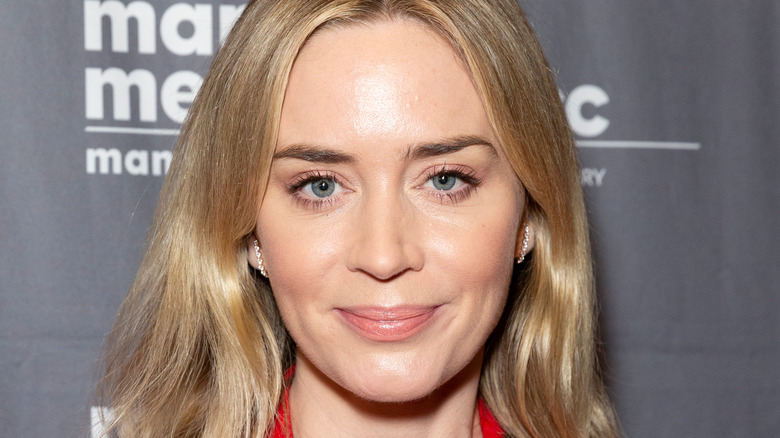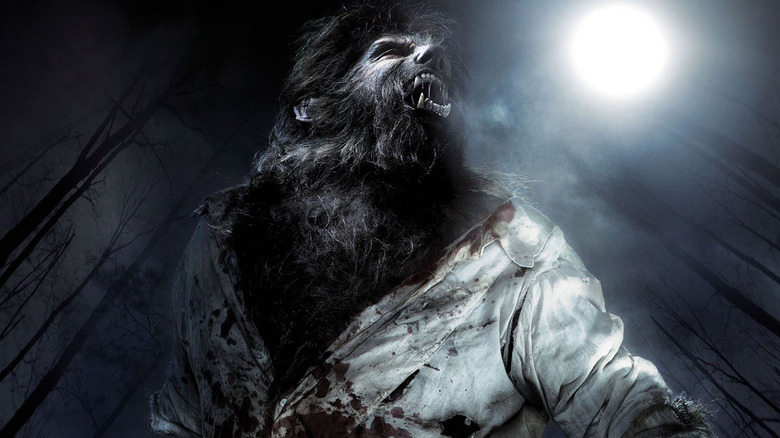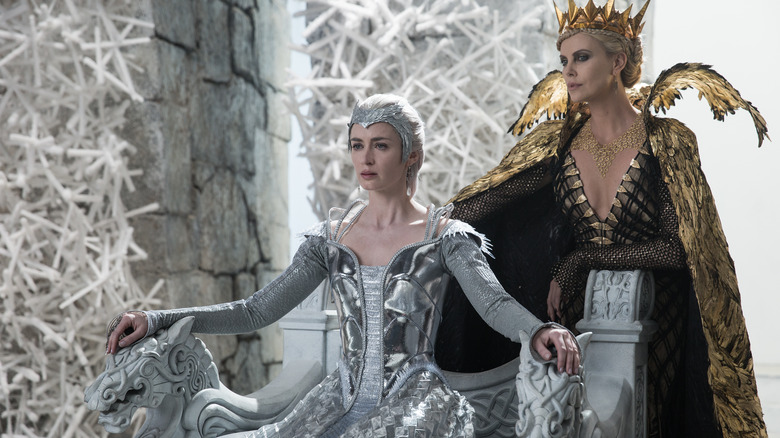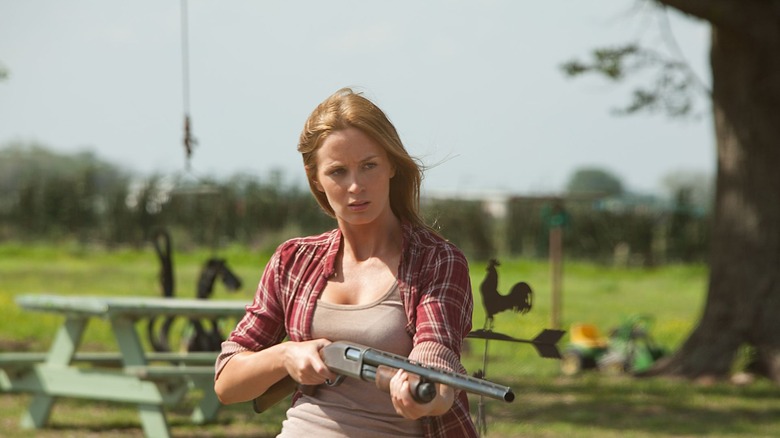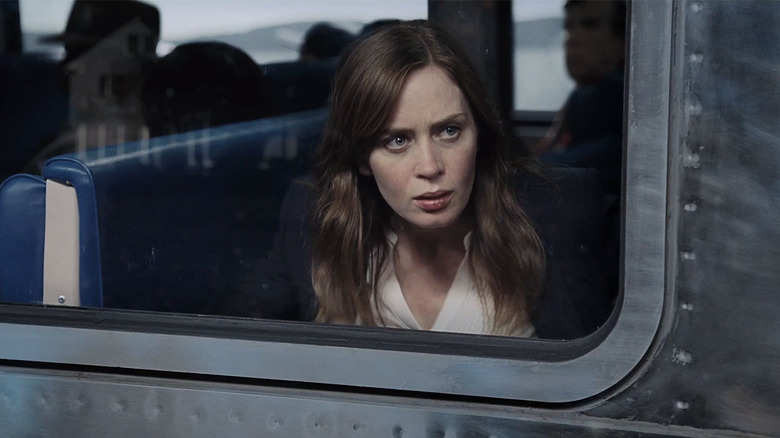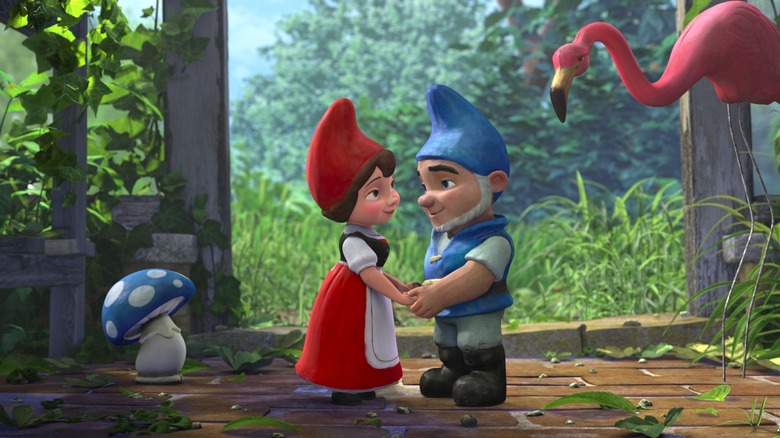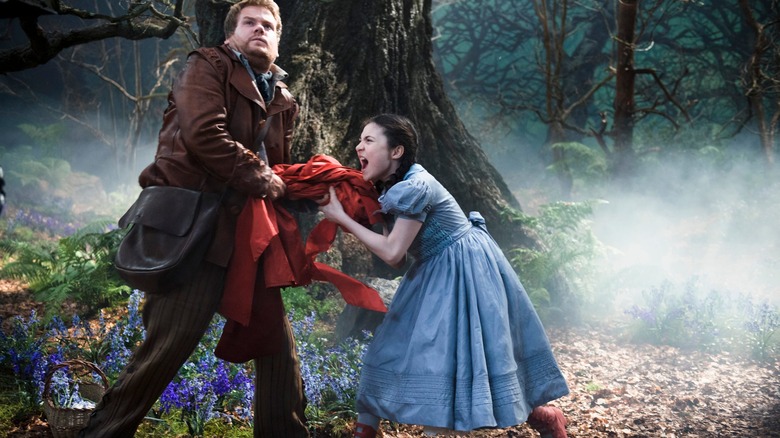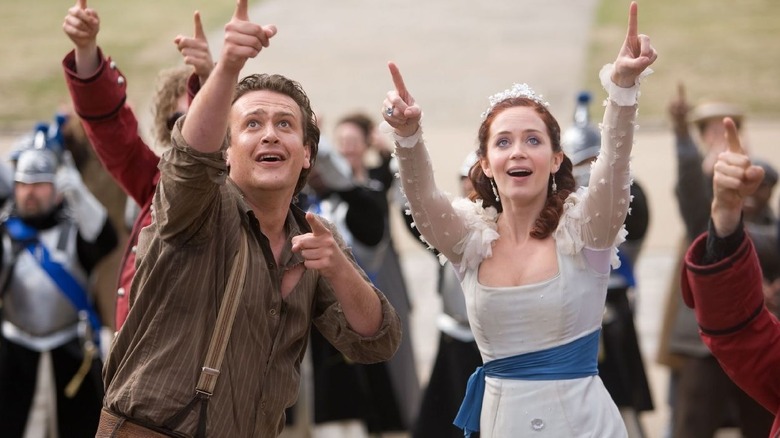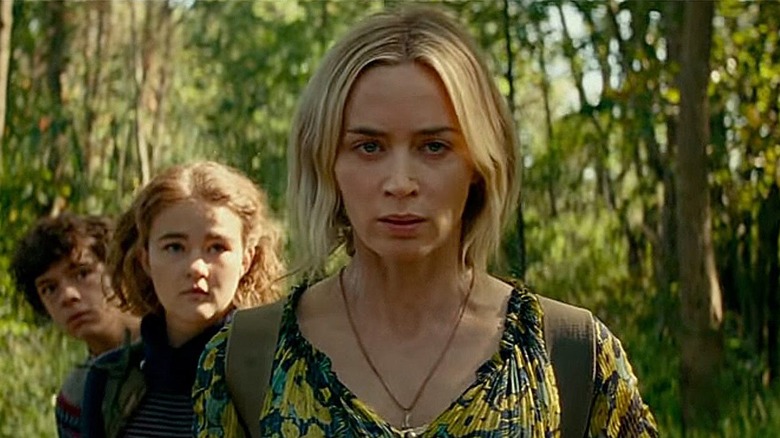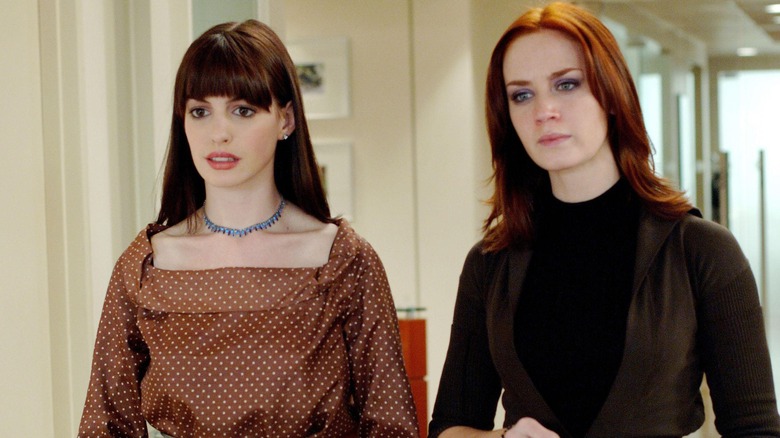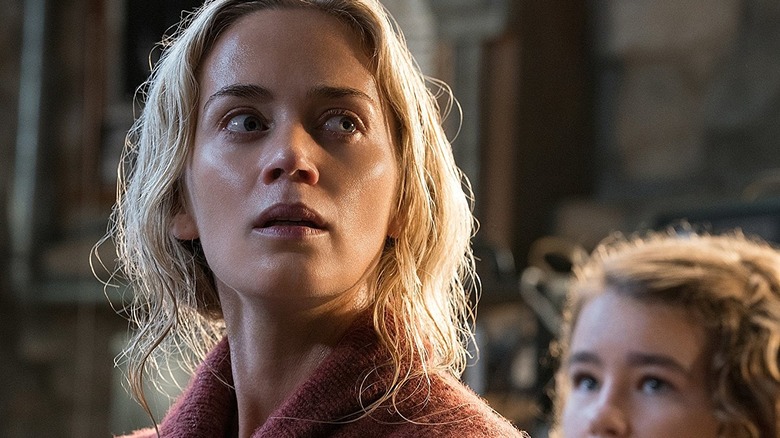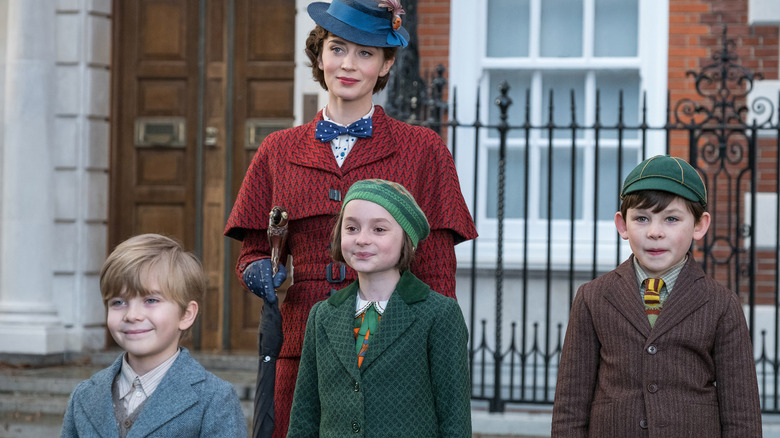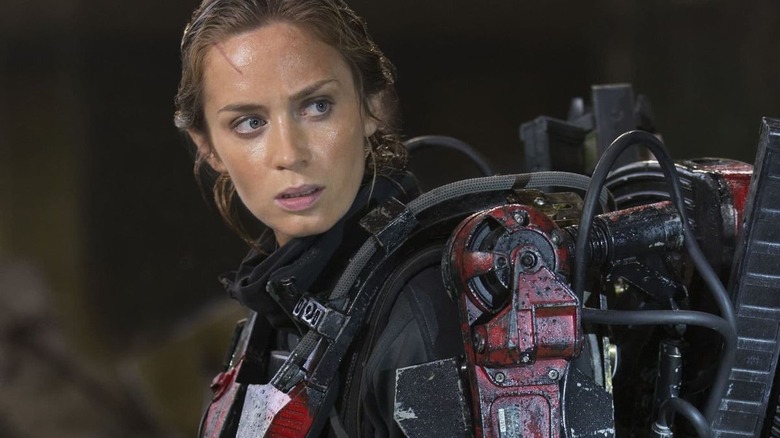The Biggest Emily Blunt Movies Of All-Time
Unlike many of today's biggest stars, actress Emily Blunt has largely eschewed franchise fare. She isn't above doing big-budget tentpoles, as "Edge of Tomorrow" and "The Huntsman: Winter's War" can attest, but she's primarily headlined movies aimed at grown-ups that aren't meant to be ongoing stories. This tendency was already apparent in her breakthrough movie, "The Devil Wears Prada:" It was major sleeper hit, but one that isn't built to sustain an ongoing cinematic universe. Embracing these kinds of features means that Blunt has never headlined a movie that's cracked $1 billion worldwide — but it also means she's built an eclectic career that spans a wide variety of genres.
This approach has also helped Blunt headline several major box office hits which stand poised to be remembered for years to come. These films don't come accompanied by a Marvel Studios or "Hunger Games" logo: Much of their appeal, in fact, is derived from the strong connection moviegoers have formed with Emily Blunt herself. With her career as strong as it's ever been, there's no better time to look back on Blunt's most lucrative projects. Join us as we explore Emily Blunt's biggest films, from "A Quiet Place" to "Mary Poppins Returns."
The Wolfman
It took a while for "The Wolfman" to find a proper place on the release calendar, as it shifted through various spots throughout 2008 and 2009. Finally, Universal gave this new take on the classic movie monster a February 2010 slot. The studio was hoping the presence of big-name performers like Emily Blunt and Benicio del Toro would help the movie become a scary-big hit, which was a pretty reasonable hope. After all, Universal struck financial gold in the 1930s and 1940s by making monster movies, not to mention 1999's "The Mummy." Surely a new "Wolfman" could also become a hit.
"The Wolfman" raked in $139 million. This isn't mind-blowing, but it does place the film ahead of several other modern monster movies. It's also a genuine testament to the enduring appeal of Universal's monster flicks. The problem here, though, is that the film cost an extraordinary $150 million to produce, a sum that no R-rated horror movie not starring Pennywise the clown could ever hope to make back. Having someone like Blunt occupy one of the film's leading roles surely helped "The Wolfman," but even she couldn't help this movie make back its enormous costs.
The Huntsman: Winter's War
In 2016's "The Huntsman: Winter's War," Emily Blunt channels her inner Elsa to portray an ice queen. Her character, Queen Freya, is the sister of Charlize Theron's villain, Queen Ravenna, from 2012's "Snow White and the Huntsman." The prospect of making a follow-up to that feature without Snow White always seemed like a dicey prospect, but this sequel is loaded with high-profile performers like Blunt, Theron, and Jessica Chastain. Could all of that star power turn this new take on the "Snow White" mythos into a franchise?
With a $164 million worldwide total, the answer to that question is a resounding "no." On a $115 million budget, "Winter's War" made nowhere near enough to justify its price tag. Moreover, its domestic total of just $48 million fell far below the original North American opening weekend of "Snow White and the Huntsman." "Winter's War" has star wattage to spare, but the biggest problem with this sequel is that the original movie just wasn't popular enough to warrant further installments. The lack of a compelling story or action beats in "Winter's War" further ensured that not even Emily Blunt could make this one click at the box office.
Looper
"This time travel stuff," Jeff Daniels intones in the trailer for 2012's "Looper," "It'll crack your brain open like an egg." That may be true, but the density of time travel shenanigans didn't keep people away from this Rian Johnson film. This is partially because the project is built on a great hook: An assassin who kills people from the future is suddenly tasked with taking out his future self. You don't need a Ph.D. to understand all the exciting possibilities in that kind of story.
That tantalizing premise is paired up with big name actors like Bruce Willis and Emily Blunt in "Looper." The presence of such performers helped assure the general public that "Looper" would not be a run-of-the-mill sci-fi-action film. Thanks to all these qualities, "Looper" managed to scare up a $176 million worldwide gross. That's an impressive haul for an original sci-fi movie in the modern movie landscape. It's also a massive improvement on the worldwide hauls of prior Rian Johnson directorial efforts. Plus, "Looper" cost only $30 million to make, which means it made back double its price tag through its $66 million domestic gross alone. Not only was this great news for the financial backers of "Looper," it added another successful picture to Blunt's impressive resume.
The Girl on the Train
In 2016's "The Girl on the Train," Emily Blunt is nobody's love interest. In fact, she doesn't even share a movie poster with a male A-lister. This is a feature that was sold as an Emily Blunt vehicle, first and foremost. It was also an attempt to recapture the success of other then-recent thriller hits like 2014's "Gone Girl." In contrast to that twisty tale, this one focuses on a woman suffering from alcoholism who is trying to remember important details about the night of a local murder.
"The Girl on the Train" did not become the next "Gone Girl," but it did prove to be a solid box office performer, with a $173 million worldwide gross. Notably, the project appealed to international moviegoers, as evidenced by its $97 million overseas gross. The lack of especially strong reviews or super famous co-stars for Blunt to interact with kept "The Girl on the Train" from becoming a super-big breakout title. However, the film flew as high as it did thanks to its popular source material, and the fact that Blunt had cultivated a positive reputation among moviegoers by this point. Audiences already associated her with memorable genre exercises, which served her well upon taking the spotlight in "The Girl on the Train."
Gnomeo and Juliet
After all kinds of production problems, 2011's "Gnomeo and Juliet" finally made it to the big screen ... and got treated as an afterthought by Disney. Released through the company's Touchstone Pictures division with only minimal marketing, this take on Shakespeare's most famous lovers, which features Emily Blunt as the titular Juliet, had all the makings of a box office non-starter.
Then, something peculiar happened. "Gnomeo and Juliet" didn't sink without a trace — it amassed $193 million worldwide on a $36 million budget, rendering it a massively lucrative venture for all involved. How did this happen? A drought of family movies in the marketplace is a big part of what made "Gnomeo and Juliet" into a sleeper hit. Plus, it's an easily explainable project (it's "Romeo and Juliet," but with gnomes!), which stood out among a glut of kiddie movies focusing on talking animals. It turns out that Elton John was really on to something when he fought so hard for the future of this quirky feature.
Into the Woods
The star-studded ensemble cast of 2014's "Into the Woods" sees Emily Blunt rubbing shoulders with everyone from James Corden to Meryl Streep. Indeed, this adaptation of the celebrated Stephen Sondheim musical has big names to spare. But even with that at its back, it remained to be seen if moviegoers would turn out for this project until the moment it hit theaters. Postmodern takes on fairy tales had proved popular in the past, but they also introduced a new problem: Had endless "Shrek" sequels and knock-offs ensured that audiences would turn their nose up at more "realistic" takes on princesses and big, bad wolves?
As it turns out, audiences around the world still had an appetite for such material. It helped that the marketing for "Into the Woods" positioned the film as less of a snarky take on fairy tales and more of a prestige Christmas musical, in the vein of 2012's "Les Miserables." Plus, the timeless appeal of seeing famous faces like Emily Blunt belt out showtunes proved once again helpful in luring moviegoers to the theater. "Into the Woods" eventually grossed $212 million worldwide, a box office profit as impressive as the movie's cast.
Gulliver's Travels
Today, the 2010 Jack Black vehicle "Gulliver's Travels" is probably best known for being the movie that cost Emily Blunt her chance to portray Black Widow in the Marvel Cinematic Universe. Blunt was the first choice for the super spy, but her contractual commitments to "Gulliver's Travels" kept her from donning that iconic catsuit. The loss of this role might have been mitigated if "Gulliver's Travels" at least became a smashing box office success ... but sadly, this flick came up significantly short.
At first glance, the movie's $237 million worldwide sum doesn't seem especially bad. However, a whopping $194 million came from international territories, with an anemic $42 million coming from North America. Worse, "Travels" cost $112 million to make. It also paled in comparison to the performance of other family movies released at the time, such as "The Chronicles of Narnia: The Voyage of the Dawn Treader." Needless to say, this made "Gulliver's Travels" a box office misfire by any standard. The fact that it cost Blunt the role of Black Widow is extra salt on the wound.
A Quiet Place Part II
2021's "A Quiet Place Part II" entered a theatrical landscape so different from its 2018 predecessor's, it was basically a different planet. One of the first major American movies to open in theaters since the COVID-19 pandemic started, all eyes were on this horror sequel. Could it help revive domestic theatrical exhibition? The expectations piled on this follow-up were, needless to say, a lot heavier than what your average "Friday the 13th" installment has to bear.
Luckily, "A Quiet Place Part II" lived up to all those weighty hopes, thanks to its $263 million worldwide gross. That includes a domestic run that not only proved successful, it made history as the first domestic release to crack $100 million since the pandemic started. That's just one of several box office feats this title achieved in North America: It was also the first movie in 15 months to exceed $40 million on opening weekend.
Thanks to the success of 2018's "A Quiet Place," this sequel was always bound to hit. All that lingering goodwill, combined with memorable early promotional material, helped "A Quiet Place Part II" stick around in moviegoers' minds throughout the entire pandemic. Its impressive box office feats also reflect how committed cinephiles were to seeing Emily Blunt return as Evelyn Abbott, a role she absolutely dazzles in.
The Devil Wears Prada
2006's "The Devil Wears Prada" wasn't just a hit — it became a bonafide classic. Opening against "Superman Returns," the $326 million worldwide gross of "Prada" came way closer to the $391 million sum earned by "Returns" than anyone could have predicted. Made on a $35 million budget, "Prada" became one of the most profitable features released in that moviegoing season, and a stunning improvement on the box office performances of prior Anne Hathaway vehicles.
There are countless reasons why "The Devil Wears Prada" became such an unexpected hit. Chief among them is the fact that it was one of that summer's few major titles aimed at the underserved female demographic. Emily Blunt's scene-stealing turn as haughty and hilarious Emily Charlton was also a major generator of word-of-mouth buzz. This breakthrough performance made audiences sit up and take notice of Blunt specifically, in addition to contributing massively to widespread praise of the movie's cast. "Prada" left such an impact on Blunt's career, in fact, that 2011's "The Muppets" features a quasi-reprisal of the character.
A Quiet Place
By 2018, Emily Blunt had appeared in a slew of different genres, ranging from romantic comedies to thrillers to action films. However, she hadn't tackled much horror. That changed in "A Quiet Place." It was an intriguing departure from her career's norms, which turned out to be just one of many ways "A Quiet Place" bucks convention. For one thing, this film is a completely original creation, with no familiar brand name to help it stand out in the marketplace. For another, it largely eschews dialogue to help render its unique post-apocalyptic world, which is dominated by monsters with extremely precise hearing.
Despite these hurdles, everyone is well aware by now what a gigantic hit "A Quiet Place" turned out to be. Grossing $340 million worldwide, "A Quiet Place" made more than horror films usually do at the international box office. Moreover, its $188 million domestic gross makes this Blunt's highest-grossing movie in North America. All the elements of this film that seemed to set it up for failure actually helped make it a gargantuan hit. That includes Emily Blunt lending her recognizable name to a horror title.
Mary Poppins Returns
The original "Mary Poppins" is one of the most famous live-action films ever released by Disney. Naturally, a sequel was inevitable. More than 50 years after the original movie debuted, Emily Blunt took over the title role in 2018's "Mary Poppins Returns." Paired up with Lin Manuel-Miranda and given a cushy Christmas release date, "Mary Poppins Returns" was positioned for box office success.
"Mary Poppins Returns" managed to gross $349 million worldwide. That's a solid sum, if noticeably down from the global grosses of the biggest live-action Disney family movies, like 2019's "Aladdin." Part of this is due to its international performance. While the $171 million domestic haul of "Returns" made it one of the biggest live-action musicals in the region, it only earned $177 million overseas. For comparison's sake, 2017's "The Greatest Showman" made $260 million overseas with no familiar brand name on its side. Still, that's the biggest complaint one could lob at "Mary Poppins Returns," which sees Blunt take up the role Julie Andrews made famous with charming results.
Edge of Tomorrow
In 2014's "Edge of Tomorrow," Emily Blunt made her first foray into action cinema. This intriguing detour reflects her willingness to embrace the new and exciting — a tendency that has often paid off for her. As a reward for stepping into a Tom Cruise sci-fi film full of fight scenes and aliens, Blunt snagged her biggest feature ever, in terms of the worldwide box office.
"Edge of Tomorrow" grossed $370 million globally, with $100 million of that coming from its domestic run and $270 million from international audiences. In terms of the box office, this move had a bit of a wild ride, with its initial opening weekend sums coming in under expectations. This did not, however, spell doom for the film: Exceptional word-of-mouth saw it stick around in the marketplace. Domestically, "Edge of Tomorrow" managed to rake in roughly 3.5 times its $28 million opening weekend — an impressive amount of retention for a summer blockbuster.
Much of moviegoers' enthusiasm for the movie stemmed from Blunt's work in the lead role: She's an even more compelling action presence than Cruise's protagonist. By stepping outside her comfort zone, Blunt didn't just score positive marks — she spurred the word-of-mouth fervor that saved the movie's box office bacon.
